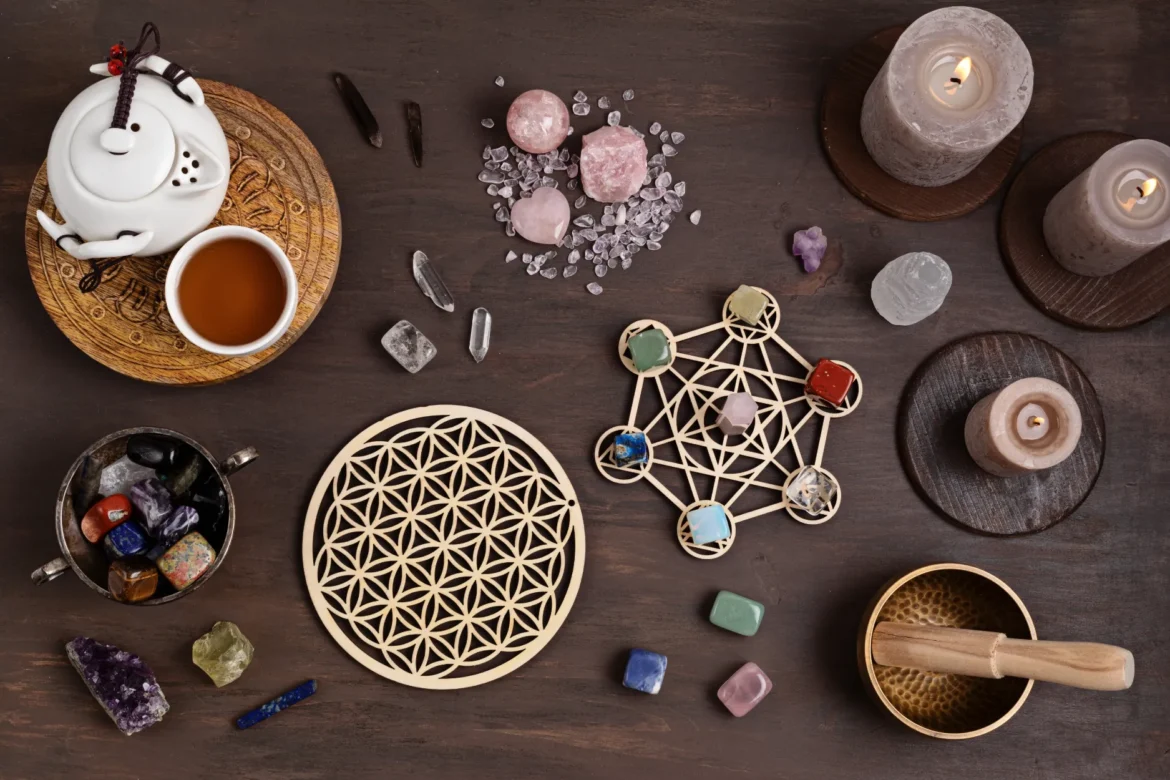How To Achieve a Stunning Interior Design: 3 Sacred Geometry Secrets
Overview
Discover the transformative power of sacred geometry in interior design. Explore balance, harmony, and aesthetics to make your interiors awesome!
“Geometry will draw the soul toward truth and create the spirit of philosophy.”
– Plato
In the realm of interior design, where aesthetics and symbolism intertwine, the timeless allure of sacred geometry has risen as a captivating muse for homeowners and design professionals alike. The concept of sacred geometry, echoing the wisdom of philosophers like Plato, transcends mere aesthetics, offering a profound connection between interior design and the very essence of our existence. It’s a concept that weaves a historical tapestry, stretching back through the annals of ancient civilizations, and now, it’s emerging as an irresistible trend in contemporary home interiors.
Sacred geometry is all about meaningful geometric shapes that go way back in time. It was a big deal in the architecture, art, and spirituality of ancient societies. Think of it like the Flower of Life and Metatron’s Cube – these patterns were like secret codes, helping people understand the universe and how things fit together. They were more than just pretty designs; they held deep meaning. The allure lies in the versatility of geometric patterns, which seamlessly blend with diverse design styles.
From the sleek, modern lines of a minimalist home interior to the intricate, ornate designs of a bohemian paradise, geometric patterns have proven their adaptability in the realm of home decor. As homeowners and design professionals continue to explore the dynamic world of home design, geometric patterns have become indispensable tools in crafting spaces that are visually striking and spiritually resonant.
The connection between sacred geometry and interior design is where the true magic happens. Interior designers and homeowners alike are discovering the transformative power of these ancient geometric principles in shaping harmonious, balanced, and inspiring home interiors. This connection isn’t just about pretty patterns – it’s about creating spaces that resonate with a deep sense of order and beauty, evoking a sense of transcendence in the everyday. In this blog, we will delve deeper into the role of geometric patterns in home design, offering insights, tips, and real-life examples that illuminate the enchanting interplay between sacred geometry and the art of interior design.
Unveiling The Legacy Of Sacred Geometry
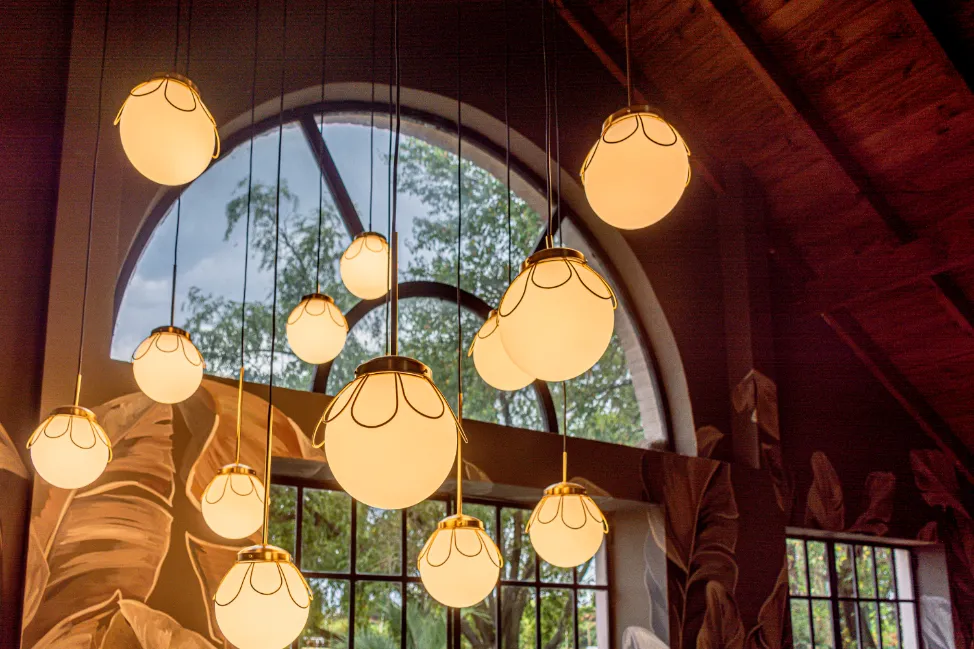
In the realm of interior design, geometric patterns hold a hidden treasure beyond mere aesthetics. They carry a rich legacy rooted in the age-old practice of sacred geometry.
Defining Sacred Geometry
Sacred geometry is more than just shapes; it’s the very language of the cosmos. At its heart, sacred geometry comprises a set of geometric principles that bear profound spiritual and philosophical importance. Its roots extend deep into history, finding origins in the architectural marvels, artistic expressions, and spiritual beliefs of ancient civilizations. Ancient civilizations like the Egyptians and Greeks employed geometric shapes as a means to communicate profound wisdom about the cosmic order, the nature of being, and the dynamic interconnection between the spiritual and material dimensions.
Principles And Symbolism
The enchantment of sacred geometry can be traced to its foundational principles and symbolism. At the core of these principles lie the fundamental concepts of harmony, balance, and proportion, which are thought to hold the key to unveiling the enigmatic secrets of the universe. Within the realm of sacred geometry, you’ll frequently encounter symbols and shapes that transcend superficial aesthetics, bearing profound metaphysical significance.
The Flower Of Life

Among the most eminent symbols in sacred geometry, the “Flower of Life” stands in a place of prominence. This mesmerizing pattern comprises a series of evenly spaced circles that gracefully overlap. Discovered in various ancient cultures across the world, it carries deep significance by symbolizing fundamental aspects of space and time. This bestows upon it the powerful representation of creation and the interconnectedness of all living entities.
Metatron’s Cube
Metatron’s Cube is yet another intriguing geometric pattern that occupies a special niche within the realm of sacred geometry. It is composed of 13 equal circles interconnected by lines and is named after the angel Metatron, believed to be a celestial scribe. Metatron’s Cube is thought to encapsulate the very building blocks of the universe, thus illuminating the interconnectedness of all life and the geometry of the cosmos.
The Golden Ratio
The Golden Ratio, often symbolized by the Greek letter Phi (Φ), stands as another vital element within sacred geometry. This ratio, approximately 1.618, is believed to embody the notion of perfect proportions and has found application in various forms of art and architecture. It serves as a cornerstone of sacred geometry, infusing designs with a touch of divine harmony.
The Connection To Interior Design
You may be curious about the connection between these ancient geometric principles and the world of interior design. By incorporating these sacred geometric principles into home interiors, designers and homeowners have the power to infuse their living spaces with a sense of transcendence. Whether through the utilization of the Flower of Life, Metatron’s Cube, or the Golden Ratio, these ancient symbols and shapes become vessels for conveying age-old wisdom and spiritual depth, making their mark on modern home decor.
Unveiling The Geometric Allure: A Contemporary Design Sensation
In the ever-evolving world of interior design, one captivating trend has emerged as the focal point of attention – the irresistible charm of geometric patterns. This section takes you on a journey through the appeal of geometric patterns in modern interior design, revealing their versatility, and sharing practical examples that can inspire your own home decor.
Delving Into The Popularity Of Geometric Patterns
Geometric patterns have taken the interior design world by storm, and the reasons behind their ascent are readily apparent. Their appeal lies in their capacity to inject charisma and individuality into living spaces. Whether these patterns are elaborate and decorative or minimalistic and streamlined, they introduce visual intrigue and depth to any room. Think of them as the exclamation points in the narrative of design, underscoring the soul of a space.
Picture a Scandinavian-influenced living room characterized by a monochromatic color scheme. Then, envision the introduction of a geometric rug adorned with diamond patterns. Almost instantly, the room undergoes a remarkable transformation, coming alive with a new energy. Geometric patterns, with their innate ability to strike a harmonious balance, provide an ideal counterpoint for minimalist design. This dynamic interplay of shapes and colors adds visual allure and vitality to the space.
The Adaptability Of Geometric Patterns
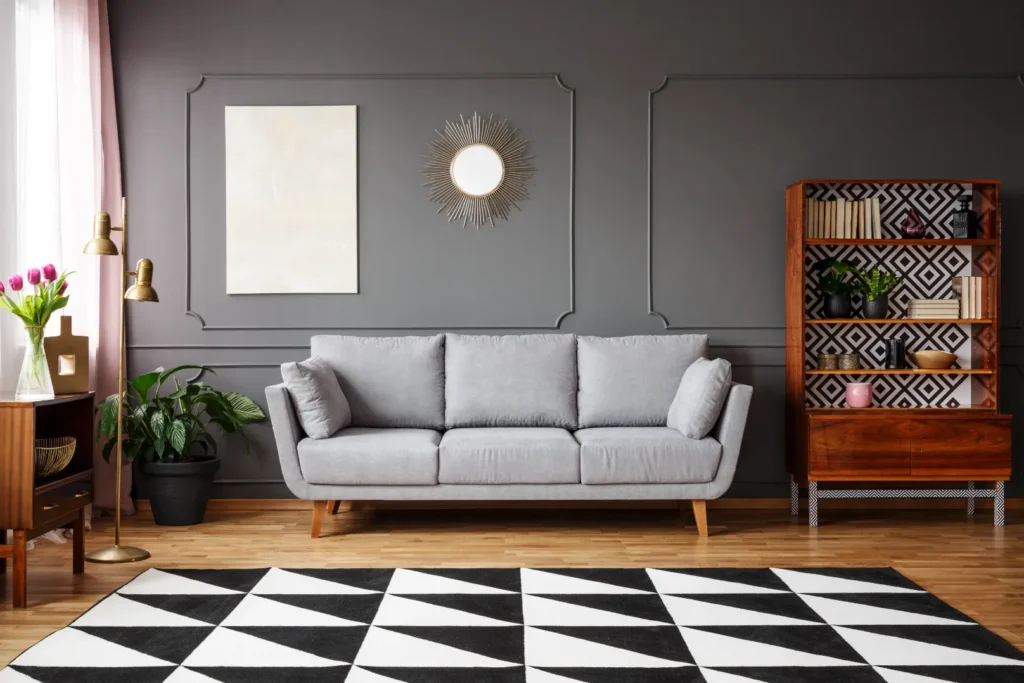
A standout characteristic of geometric patterns is their knack for seamlessly fitting into a range of design styles. Whether you favor a modern, mid-century, or bohemian look, there’s a geometric pattern to match your vision. Their versatility lies in their ability to play different roles in a design scheme.
For instance, in a contemporary, minimalist home, geometric patterns can provide a sense of structure and order. You might see clean lines and sharp angles in furniture, lighting fixtures, and wall art. These patterns create a sense of precision and add a touch of sophistication to the space.
On the other hand, if your heart leans towards the bohemian style, geometric patterns can provide a vibrant and eclectic touch. Think of brightly colored throw pillows with geometric shapes, or an intricate geometrically patterned area rug that anchors the room. These patterns add a playful and free-spirited element to the design.
Examples Of Geometric Pattern Applications
To truly grasp the appeal of geometric patterns, let’s explore how they’re practically applied in home decor and design:
Geometric Wallpaper: A living room with a subtle geometric wallpaper can add depth and interest to the space without overwhelming it. This is a popular choice for homeowners looking to make a statement in a specific area, like an accent wall.
Geometric Rugs: Rugs with geometric patterns are a versatile choice. In a neutral room, a geometric rug becomes the focal point, whereas in a busier space, it adds a sense of order and cohesion.
Geometric Tiles: Geometric tiles are frequently seen in bathrooms and kitchens. They can transform a simple white bathroom into a modern oasis, or add an artful touch to a kitchen backsplash.
Geometric Furniture: Furniture with geometric designs, like a coffee table with a hexagonal base or chairs with sharp angles, infuses a sense of modernism into a space.
Geometric Wall Art: Geometric wall art pieces can serve as striking focal points. Consider a series of triangular shelves or a metal wall sculpture with geometric shapes.
In essence, geometric patterns have found their place as the go-to tool for interior designers and homeowners to infuse life and character into their spaces. Their adaptability across various design styles ensures that there’s a place for them in every home, making them an enduring and beloved choice in contemporary interior design.
The Synergy Of Geometry And Interior Design
In the domain of interior design, the timeless quest for harmony and equilibrium within living spaces persists. Sacred geometry principles present a profound avenue for elevating the ambiance of interiors. Let’s delve into the mechanics of these principles, the specific geometric forms that foster equilibrium and balance, and unveil actual instances where sacred geometry seamlessly integrates into interior design.
Elevating Interior Spaces With Sacred Geometry
The integration of sacred geometry principles into interior design transcends the superficial arrangement of shapes; it’s an art of crafting spaces that resonate with a profound sense of equilibrium and harmony. At its essence, sacred geometry serves as a blueprint for deciphering the innate order of the universe, a blueprint we apply to interior spaces, creating an environment that not only visually pleases but elevates the human spirit.
By infusing sacred geometry into the design, a room can become a sanctuary of balance. In such spaces, every element, from furniture placement to color selection, adheres to divine proportions. This harmonious blend doesn’t solely enhance aesthetics; it augments the energetic flow within the space.
The Significance Of Particular Geometric Shapes And Patterns

Several distinct geometric shapes and patterns play pivotal roles in nurturing balance and harmony within interior design:
The Circle: Circular motifs, like the mandala, exude a calming influence and find application in various design elements, from chandeliers to mirrors, and even as wall art motifs. They foster a sense of unity and completeness within a space.
The Rectangle: Rectangles and squares introduce a feeling of stability and order. They are frequently utilized in furniture and architectural elements to confer structure and organization upon a room.
The Golden Ratio: As previously mentioned, the Golden Ratio, symbolized by the Greek letter Phi (Φ), stands as a fundamental element of sacred geometry. It serves to ensure that design proportions are not only visually pleasing but harmonious, whether in the placement of artwork or the dimensions of furnishings.
The Flower of Life: This ancient pattern, characterized by overlapping circles, symbolizes the interconnectedness of all life. When integrated into design, it imparts a sense of unity and balance.
Real-Life Illustrations Of Harmonious Spaces
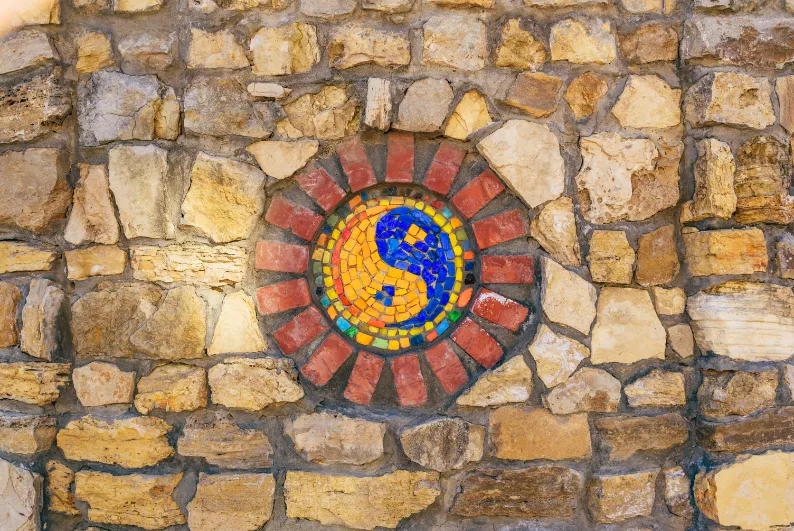
To fully comprehend the transformative potential of sacred geometry in interior design, consider a few real-world case studies:
Harmony Through Yin-Yang: Within a meditation room, the floor adorned with the yin-yang symbol, meticulously aligned with specific geometric proportions, fosters an atmosphere of complete equilibrium. This space not only engages the senses but nurtures a profound feeling of tranquility and balance.
Energetic Hexagons: In a spa setting, the repeated usage of hexagonal tiles on both walls and floors introduces a palpable sense of balance and unity. This design seamlessly aligns with the principles of sacred geometry, bestowing a serene ambiance upon visitors.
Symmetry with Mystical Allure: In a contemporary living room, the integration of sacred geometric patterns within throw pillows and art pieces adds depth and symmetry. These patterns contribute to an overall sense of order and interconnectedness, enhancing the room’s harmonious atmosphere.
The incorporation of sacred geometry principles and specific shapes into interior design bestows a unique opportunity to craft spaces that transcend visual appeal. These spaces evoke a sense of balance and unity, effectively transforming them into harmonious sanctuaries for the soul. In the upcoming sections, our exploration will continue, providing insights and inspiration for your own home decor endeavors.
Mastering The Art Of Geometric Patterns In Your Home
The appeal of geometric patterns in interior design is unquestionable. However, for homeowners, the question remains: How can you adeptly integrate these captivating designs into your decor? In this section, we offer practical tips, suggest complementary color schemes and materials, and provide guidance on achieving the perfect balance between geometric patterns and other design elements.
Practical Advice For Homeowners
Start Small: If you’re new to using geometric patterns, begin with smaller items such as throw pillows, blankets, or artwork. These elements allow you to experiment with patterns without overwhelming the entire space.
Choose a Focal Point: Select one area or piece of furniture to be the focal point for geometric patterns. It could be a boldly patterned rug, an accent wall, or even a statement piece of furniture. This draws attention while maintaining balance.
Mix and Match: Don’t hesitate to mix different geometric patterns. Stripes, chevrons, and abstract shapes can coexist harmoniously. Just ensure they share a common color palette for coherence.
Color Schemes And Materials

Neutrals with a Pop: Neutral backgrounds, like white, beige, or gray, provide a perfect canvas for geometric patterns. Inject bold, contrasting colors to create visual impact. For example, a neutral living room with vibrant geometric throw pillows can be incredibly striking.
Metallic Accents: Incorporate metallic materials, such as gold or silver, to add a touch of luxury. Geometric patterns in metallic finishes on items like mirrors or light fixtures create a chic and modern look.
Natural Elements: Consider incorporating natural materials like wood or stone alongside geometric patterns. This combination adds warmth and a tactile element to the space, balancing the crispness of geometric designs.
Balancing Geometric Patterns With Other Elements
Scale Matters: Vary the scale of geometric patterns. If you have large-scale patterns on the walls or floor, balance them with smaller-scale patterns in textiles or accessories. This contrast adds depth and interest.
Space Planning: Ensure there’s adequate space between different geometric elements to avoid visual clutter. Adequate spacing provides room for the patterns to breathe and be appreciated individually.
Play with Geometry: Incorporate non-patterned geometric elements into the decor. Think geometric shapes in furniture or accessories. For instance, a coffee table with a geometric base can harmonize with patterned textiles.
Practical Examples
Living Room: A white living room with geometric patterns can feature a navy blue geometric rug as a focal point, along with smaller-scale geometric throw pillows and a modern geometric coffee table. The result is a chic and inviting space.
Bedroom: In a bedroom with a neutral color scheme, consider adding geometric patterns through bedding. A duvet cover with a bold geometric print can be complemented by bedside lamps with geometric bases, creating a balanced yet visually intriguing room.
Kitchen: In a modern kitchen, geometric patterns can be introduced through backsplash tiles. These tiles can be balanced with wooden countertops and metal geometric pendant lights, creating a harmonious and contemporary cooking space.
Incorporating geometric patterns into your home decor is not as daunting as it may seem. With the right balance, choice of materials, and color schemes, geometric patterns can transform your living spaces. Remember, the key lies in careful selection and thoughtful placement.
Conclusion
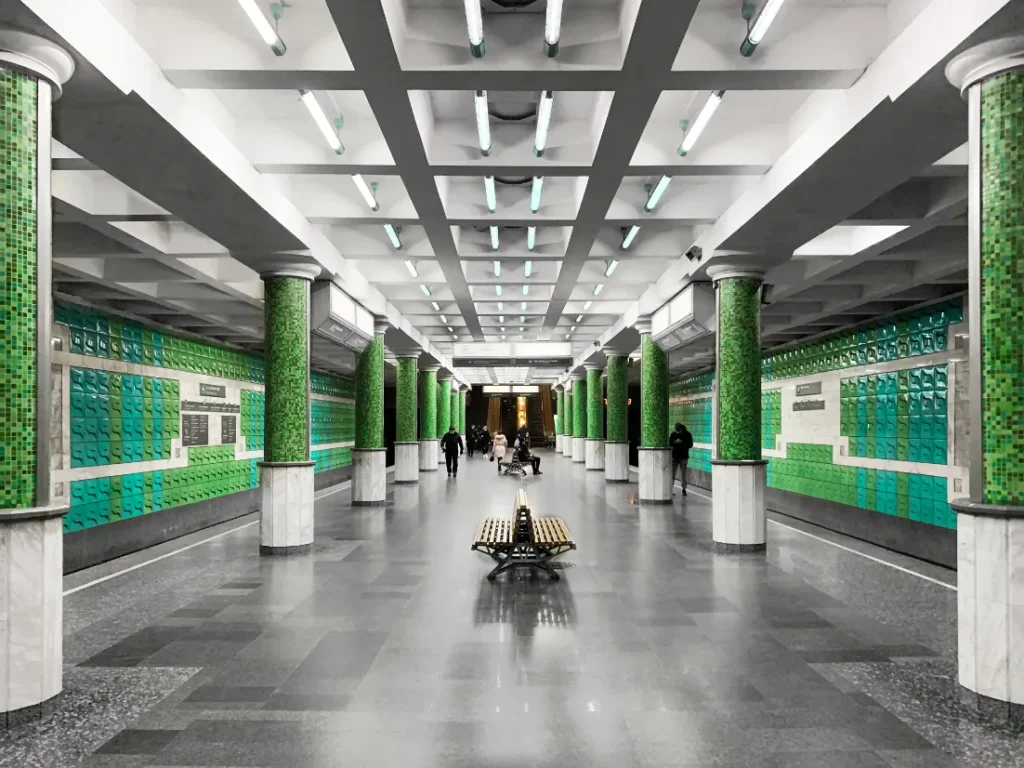
In the realm of interior design, the convergence of sacred geometry with contemporary decor has unlocked a realm of boundless possibilities. From intricate motifs like the Flower of Life to the meticulous harmony of the Golden Ratio, these sacred principles have revolutionized the way we perceive and engage with our living spaces. Concluding our exploration of the seamless interplay between sacred geometry and interior design, it’s evident that these principles extend beyond mere aesthetics. They delve into the very essence of our homes.
Geometric patterns, once confined to ancient temples and mystical symbols, now find a meaningful place within modern households. They provide a profound sense of equilibrium and oneness. The practical insights we’ve shared empower homeowners to embark on their unique design journeys, deftly weaving the wisdom of sacred geometry into the tapestry of their living spaces.
So, embrace the enduring wisdom of sacred geometry, allowing it to infuse your living spaces with equilibrium, unity, and a touch of the divine. Your home becomes more than a dwelling; it transforms into a canvas where the art of sacred geometry beautifully resonates, bridging the ancient and the contemporary in perfect unison.
Experience the difference with The White Frame. We don’t just follow design trends; we elevate your living space using sacred geometry principles. It’s time to turn your home into a harmonious haven. Explore some of our work Here.
Contact us today for a consultation and discover the art of balanced living.


